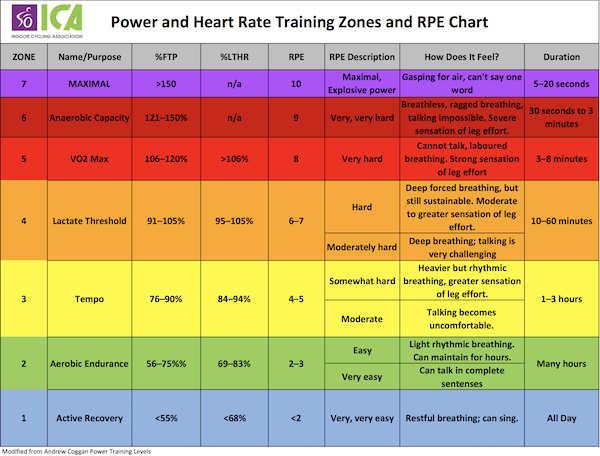To me, it all depends on what one means by zone 5. By looking at the chart post 25, since zone 5 is at the top and the hardest I'd expect it to be an all out effort, but I guess that's NOT what that particular chart is saying. I personally, like this chart better, because it's more specific. All out efforts can only be maintained for a matter of seconds.
https://www.indoorcyclingassociation...t%20percentage.

I personally do a lot of zone 4 - 7 efforts, I'm a pretty good sprinter. So High-heat training does not limit me in the least, if any thing it helps because it is advantageous in many respects, as studies have shown.
https://tgr.run/2018/04/30/heat-trai...ude%20training.
Training in the heat adds extra settings to your blood flow (hypervolemia). Blood volume is the sum of red blood cells and plasma volume. Red blood cells transport oxygen, while more plasma allows your heart to pump more volume per beat per minute (greater cardiac output). Blood volume is a big determinant in performance, and it can change with proper heat training.
Training in the heat can increase the rate of perspiration, increase a runner’s blood plasma volume (which leads to better cardiovascular fitness), reduce overall core temperature, reduce blood lactate and even increase skeletal muscle force. Heat acclimation can be as efficient or even more than altitude training. Heat acclimation provides more substantial environment specific improvements in aerobic performance than altitude training. Heat training not only does a better job at increasing VO2 max, but it also makes runners better at withstanding a wide range of temperatures.
Training in the heat properly can have extraordinary effects. Studies have shown that heat training not only can expand blood plasma volume, but there seem to be some changes in the heart’s left ventricle, which helps to increase oxygen delivery to the muscles. Runners who train in hot weather, tend to get better at regulating heat by sweating earlier and developing a colder resting body temperature. Training in hot weather, runners have to compromise training quality for the heat acclimation. When starting to run in hot weather, the heat is additional stress to the body just like more intense training sessions (intervals) or running longer distances.
I understand the issue/concern some have of having to exert oneself less in high-heat conditions, but that's not a bad thing, because most people already workout too hard every time they go for a run/ride. Most people automatically run/ride in at least zone 3 when they should be doing zone 1 or 2. That way you're not overly stressing yourself and you're still getting all the aerobic conditioning, meaning when you do the zone 4 and above workouts, you can get the most out of them, because you're fresh.
Whenever I feel myself getting too fast, I think of this video presentation, it's very interesting and only about 3-minutes long. Key take away, when your working at about 60% max H/R, your heart is pumping the max blood volume....I'll let Dr Jack Daniels explain the rest